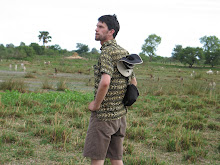I wrote this piece last year, well before the current political crisis facing Mali was on anyone's agenda. It's incredible how quickly a country's fortunes can change due to an unfortunate conjuncture of global events (Libya) and structural political problems (Mali's north and systemic government corruption). I only hope that the people of Mali return to the horizon of possibilities that seemed to characterize the country when I wrote this. -Leif B. June 2012
Riding from Kita to Bamako (July 2011)
I particularly enjoy the trip from Kita, a provincial city in western Mali, to Bamako, the Malian capital, for a number of reasons. At first glance, it is a fairly non-descript, even desolate stretch of road through the West African savanna. But it hosts a number of subtle yet profound signs of the ways in which Mali and the West African region are changing.
One’s first impression of the Kita-Bamako route is the surprising lack of settlement and people. Even for a sparsely populated region like West Africa, this area stands out for its stretches of road where villages and visible signs of people are absent. One of many historical reasons for this is that until just a few years ago, the only viable link between western Mali and the rest of the country was a train built by the French in the early 20th century. Often sporadic at best, train service to the region was and continues to be grossly inadequate: residents speak of frequent shortages of basic goods, such as sugar and bread, as well as incredibly long trips between cities. Western Mali’s major economic output was cheap labor, that was largely exported to coastal countries such as Cote d’Ivoire and Nigeria. Development in this region, in many ways, was held back as a result, until Mali’s first post-Revolution President Alpha Konaré made ‘desenclavement’ one of his top priorities.
The train still rumbles along at 35-40 mph, often in parallel with the brand new highway that will soon link Bamako to the Senegalese capital and port city of Dakar. Brand new Renault 18 wheelers, an eye-catching contrast to the typically decript Malian Berliet trucks, are beginning to appear on the road, which will make the trip between the two cities dramatically quicker and easier. New settlements are popping up, including one within a national forest that is populated largely by Malians who fled the conflict and xenophobia in the Ivory Coast. Villages that had once sustained themselves by their location on the train tracks are now without an economic raison d’etre. Many are moving to the side of the highway to sell products to travelers or just have access to the frequent ground transport that runs to Bamako.
As one reaches the mid-point of a journey, an enormous cement factory stands on the side of the highway that is under construction by a Chinese company. Although the growing Chinese economic presence on the continent is relatively well-covered in the media, the story of this one particular factory includes an interesting and overlooked element: Malian cement importers resisted its development as it stands to cut into their substantial profits on the exhorbitant cost of foreign cement, from which virtually all urban buildings are built. As one stops to look at the progress of the cement plant’s construction and perhaps contemplate the effects that economic opening will have on Malian society, several trucks filled with log rounds might pass by. These might be destined for the domestic market, but they might on their way to China, which, of course, has a huge demand for tropical hardwood timber. Villagers in a remote part of western Mali recently caused a brief national scandal when they exposed a shadowing Chinese company employing foreign lumberjacks from Guinea to cut trees on their village lands.
Arriving in the Bamako suburbs, a traveler might notice the intensivly cultivated gardens on the outskirts of villages. Fenced in plots of papaya and mango trees along with various horticultural products such as lettuce, okra, and tomatoes have become a prime money maker in peri-urban areas and, subsequently, has dramatically altered social relations within village communities as younger members earn cash and gain clout. Market gardening wouldn’t be what it is without cell phones and soon the ubiquitous Orange signs, marking the cellular subsidiary of France Telecom are hanging outside of every boutique.
At the police check point marking the arrival into greater Bamako, two billboards stand out: one for the Port of Dakar and one for the principal port of Ghana. Notably absent is Cote d’Ivoire, West Africa’s former economic engine and host of countless Malian immigrants. The flow of people has now reversed: Ivoirian restaurants and bars now dot Bamako’s urban landscape and Cote Ivoire is in ruins following over a decade of internecine fighting. If Cote d’Ivoire is Mali’s (and, perhaps, France’s) past, Senegal likely represents at least part of its future. As the country continues to capture regional market share from Cote d’Ivoire, its trucks and people will ply the new highway through Kita with increasing frequency.
The abandonment of the railroad for the new highway is a new economic reality and a potent symbol of Mali’s fading colonial past. As new foreign investors enter West Africa, led by the Chinese but complimented by many others, including the new Canadian owners of the railway, a new economic landscape emerges. Western Mali’s abundant land could become attractive to Malian or foreign agricultural entrepreneurs, especially if the regional cotton business is sold to a Taiwanese consortium.
Whatever does end up happening to this unique and lesser known region that has played such an important role in Malian history, the Kita-Bamako trip will inevitably look comletely different in a few years time. This essay has included just a few of the arguably superficial changes, larger demographic and ecological changes promise even more profoundly different landscapes down the road.
Subscribe to:
Comments (Atom)

